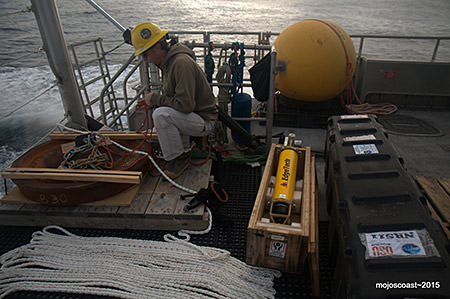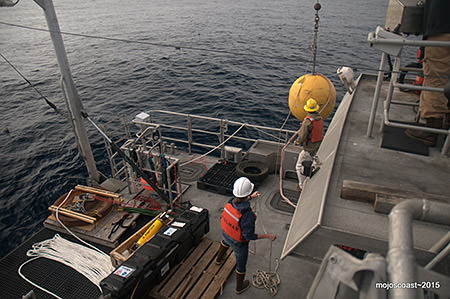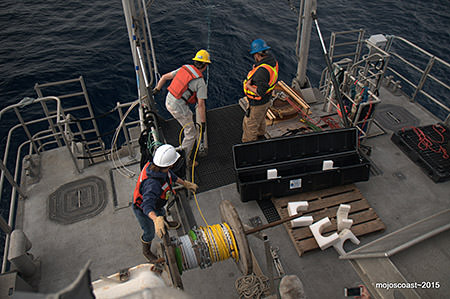Noise
Cordell Bank
Why is it a concern?
The level of noise pollution in the oceans has increased dramatically the last 50 years, with much of the increased noise due to commercial shipping. As shipping traffic increases and ships get bigger and noisier, ocean noise could become a larger issue within sanctuaries. Sonar activities, including sonar from military vessels are another noise source within sanctuary waters.
Ocean noise impacts organisms in many ways: it can mask communication, reduce growth and reproduction, interfere with foraging, and disrupt reproductive activities. Many marine mammals respond to noise by altering their breathing rates, increasing or reducing their time underwater, changing the depths or speeds of their dives, shielding their young, changing their song durations, and swimming away from the affected area. Extreme noise pollution may cause temporary or permanent haring loss in marine mammals and other organisms. Disorientation and hearing loss may account, in part, for cases in which ships collide with marine mammals that are apparently unaware of the approaching vessel. Oil exploration-related seismic surveys may cause fish to disperse from the acoustic pulse with possible disruption to their feeding patterns. Available data on fish indicated potential effects on sensitive egg and larval stages within a few meters of the sound source.
Overview of Research

Research conducted by Sanctuary scientists and partners provides critical information to address existing and emerging resource conservation and management issues. The Overview of Research highlights some, but not necessarily all, of the research activities completed or ongoing at the Sanctuary.
An acoustic mooring was deployed in October 2015 in the sanctuary that will record ambient, low frequency sounds in the ocean, such as commercial ships and large whales that vocalize. This monitoring program is part of the NOAA Ocean Noise Reference Station Network - a unique network of hydrophones that collect consistent and comparable long-term acoustic data sets covering all major regions of the U.S. The hydrophone will be retrieved in 2017 and will assist researchers in determining a baseline soundscape profile for the sanctuary.
Contact Danielle Lipski with questions.
Science Needs and Questions
The best available science is used by Sanctuary scientists and managers working to address priority resource conservation and management issues. As priorities change and new issues emerge, each Sanctuary develops new science needs and questions and works with partners to address them.
- Also see the CBNMS Science Needs Assessment related to noise for additional information
- What are the relative inputs of sound from various sources to the Sanctuary’s total soundscape and how do they vary at temporal and spatial scales?
- What species of vocalizing marine mammals are heard and when are they present?
- What are the temporal and spatial variations of vocalizing marine animals in the Sanctuary?
- What is the spatial and temporal overlap of anthropogenic sound and marine mammals in the sanctuary?
- Are changes in the behaviors of vocally-active marine animals relative to anthropogenic sound sources biologically significant, and how can this information inform underwater noise policy for the Sanctuary?
Education and Outreach Material
Please refer to the Cordell Bank National Marine Sanctuary website to learn more about education and outreach materials.
Discovery of Sound in the Sea website offers many resources related to the issue of noise in the ocean.
Podcast on Noise and Soundscapes in National Marine Sanctuaries with Dr. Leila Hatch.
References
Haren, Angela M. "Reducing noise pollution from commercial shipping in the Cordell Bank National Marine Sanctuary: a case study in marine protected area management of underwater noise." Journal of International Wildlife Law and Policy 10.2 (2007): 153-173.
McKenna, M. F., et al. "A quieting ocean: Unintended consequence of a fluctuating economy." The Journal of the Acoustical Society of America 132.3 (2012): EL169-EL175.
McKenna, Megan F., et al. "Underwater radiated noise from modern commercial ships." The Journal of the Acoustical Society of America 131.1 (2012): 92-103.
McKenna, Megan F., Sean M. Wiggins, and John A. Hildebrand. "Relationship between container ship underwater noise levels and ship design, operational and oceanographic conditions." Scientific reports 3 (2013).
Polefka, S. 2004. Anthropogenic noise and the Cordell Bank National Marine Sanctuary, a report by the Environmental Defense Center.
Adopted by the Cordell Bank National Marine Sanctuary Advisory Council. Unpublished report.




